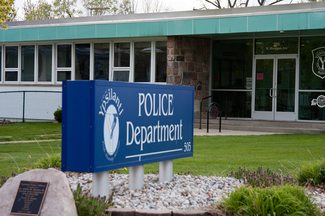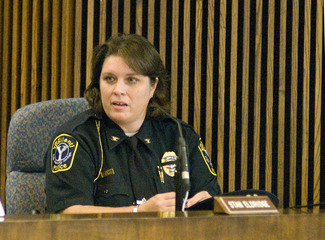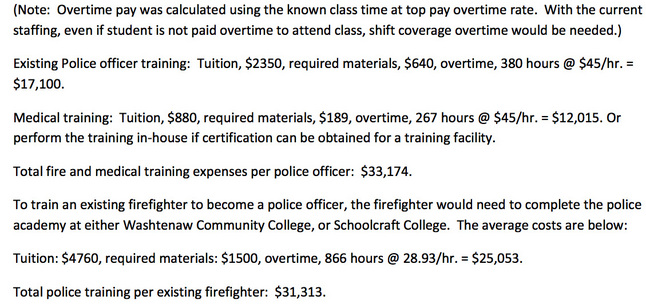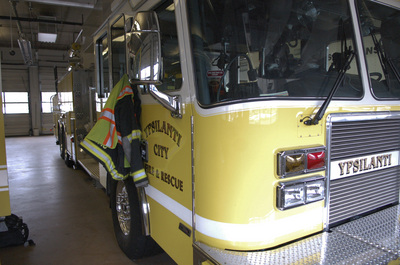- Previous story: SEMCOG report: $2M in additional cuts, revenue enhancements needed to keep Ypsilanti solvent
Ypsilanti City Manager Ralph Lange says the city will pursue a hybrid model for its police and fire departments to reduce expenses and maintain services, as outlined in a new report from the Southeast Michigan Council of Governments.

SEMCOG is recommending a hybrid model for the police and fire departments.
The SEMCOG Local Government Effectiveness and Collaboration team examined the two departments to see how the city could improve its services, while being cost effective.
In its report, SEMCOG said if no changes are made, the city will continue to see a decrease in the level of emergency services provided from both departments.
"Personnel will become burned out, the potential of injury increases and morale will continue to fall," SEMCOG wrote. "The overtime that both departments are consuming in order to provide service will cripple the city and take its toll on the employees. This is not a viable option."
The report was sent to Lange, who requested the services and is leading the charge for the re-organization.
"We're looking at Chief (Amy) Walker as a likely candidate to be director of public safety and police chief," he said. "Clearly she knows a lot about public safety."

Ypsilanti Police Chief Amy Walker speaks at a 2010 meeting.
Tom Perkins | AnnArbor.com file photo
What would the hybrid model look like?
Monroe has a full-time fire department, supplemented by trained police officers. Monroe has 12 full-time firefighters under the direction of one chief, along with 32 cross-trained officers. The police department has 56 officers in total.
The hybrid model in Ypsilanti would have separate police and fire departments with an "adequate" number of firefighters to respond to daily service demands.
Under the direction of a new public safety director, there will be a deputy police chief and a deputy fire chief.
This would be coupled with a larger police department that would have a certain number of cross-trained officers that have been trained and equipped to respond to major fire incidents whenever the fire department is busy or on another run.
"It's indicated in the report that there are some creative approaches for police and fire being developed," said SEMCOG Fiscal & Operational Consulting Services representative Dave Boerger. "I think the existing fire and police departments were aware of it (the hybrid model) and were studying it. I think it's getting some traction."
The hybrid model would differ from a full public safety model, such as the one implemented in Kalamazoo, which cross-trains both the police and fire departments.
SEMCOG stated the fire department would be able to retain its skill set and knowledge base of the fire service, retain its own administration and inspection division. However, in terms of response, it would be smaller in size for the number of daily runs firefighters respond to.
This would call for a smaller number of fire personnel as a minimum, which would reduce overtime expenses, but would not necessarily reduce the total number of firefighters below current levels, according to SEMCOG.
Minimum staffing for daily runs and the number for the total force would still need to be determined, though.
With this model, the police department would need to hire additional personnel, and in consort with the fire department, determine the number of cross-trained officers needed.
By reducing minimum staffing in the fire department and increasing officers on the road, it may result in reduced overtime in the police department as well.
Lange said at a recent council meeting that the two departments have incurred between $600,000 and $700,000 worth of overtime in recent years.
Lange reiterated the model will not move forward without union negotiations being completed. The city is currently negotiating both police and fire contracts.
"We're moving in that direction, but it can't be finalized until those contracts are settled," Lange said. "If they're not, then you (may) have a whole different operation. ... You just have to wait and see. In this case, the particulars won't be known until contracts are settled."
Are there alternatives to the hybrid model?
Increasing the level of personnel for both departments to deliver service and reduce overtime would solve a few of the issues, but would prove to be fairly expensive.
"With the economic crisis that has affected Michigan municipalities resulting in devastating loss of tax revenue, hiring personnel in the numbers needed is for many communities, including the city of Ypsilanti, essentially impossible," SEMCOG wrote.
The only way to make this happen, according to SEMCOG, would be a millage directed toward police and fire service, but the city would have to decide if it is a viable option to go before the voters to ask for a tax increase.
Another possible option would be to move forward with a full-fledged public safety department.
A chart obtained by AnnArbor.com in October showed that possible discussions have taken place regarding the implementation of a full public safety department within the city. The plan that was being considered potentially called for a fire deputy chief, police deputy chief and a director of public safety whose responsibilities would encompass the entire department. All together there would be about 42 employees. Of that number, nearly 20 would be cross-trained public safety officers.
If implemented, Ypsilanti would have been the first city within the county to cross-train police and firefighters.
SEMCOG analyzed the projected costs of this model.
To train an existing police officer to perform fire department functions, the officer would complete the fire academy, become a basic emergency medical technician and obtain a certification in Pre-hospital Trauma Life Support.
To train an existing firefighter to become a police officer, the firefighter would need to complete the police academy at either Washtenaw Community College, or Schoolcraft College. The training costs would be a one-time expense for current employees.
See the chart below for expected costs:

The chart shows the projected costs to cross-train police officers and firefighters.
SEMCOG report
Boerger said SEMCOG is not in favor of this model.
"Converting from standalone departments to a full-fledged safety department has been problematic wherever it's tried," Boerger said. "It's fallen through."
Boerger said SEMCOG is recommending the hybrid model not only because training would cost less since only police would be cross-trained, but he believes the transition would be easier for the city.
"There would be less resistance," Boerger said. "It’s much more easy to implement this. With the full model, that means your existing police and firemen have to be retrained to do the opposite skills which has really been the challenge. This approach is easier because you’re not dismantling the fire department."
Lange said it was never the city's intention to dismantle the fire department or create a full-fledged public safety department.
"That is not what we're talking about," Lange said. "There would still be a police department and fire department. It's a complete and total hybrid."
Why is change needed within the departments?
The Ypsilanti Police Department is currently staffed by 25 sworn officers and four civilians. This represents a decrease from two years ago when the force was made up of 40 sworn officers and nine civilian employees.
SEMCOG said its research showed the reduction in staffing was necessary due to a declining tax revenue, but the reduction has had a major impact on service delivery, department morale and overtime expenses.
The police department accounts for about $5 million of the general fund.
The latest SEMCOG data from 2011 show that with a population of 19,435 people, Ypsilanti has 12.8 officers per 10,000 residents, which is well below the benchmark of 16.
Two years ago, the department had 20.5 officers per 10,000 residents.
The benchmark number of dispatched calls per officer also has been affected. The department handles about 20,000 calls per year, with 800 being handled by each officer. SEMCOG said this is far above the average of 570. When the workforce was at 40 sworn officers, each officer handled about 500 calls.
Currently, of the 25 sworn officers, 18 are dedicated to road patrol. One lieutenant supervises that division, with the remaining sworn personnel being Chief Walker and five employees within the detective bureau.
Road patrol officers work 12-hour shifts, with three on each shift. Walker established a policy of three officers on duty as a minimum to safely handle calls. However, SEMCOG noted that with only three on duty, any time an officer takes a day off, overtime is required.

The fire department also has been faced with budget reductions and cuts.
AnnArbor.com file photo
SEMCOG believes the police department needs more officers on the force and a hybrid model could potentially alleviate the stress on current staff.
"Even if the minimum staffing was supported by the needed buffer, three officers on duty each shift is not sufficient to provide adequate police service without sacrificing basic police service, such as undesignated patrol," SEMCOG wrote in a report. "The chief believes the city should be covered by four officers on the day shift and five officers at night, and based on the call volume, this seems like a reasonable staffing scenario."
Just like the police department, the fire department has been faced with setbacks and budget cuts. The department accounts for $2.5 million of the general fund and has seen a reduction in staff as well. At peak in the 1980s, the department had 35 firefighters. It now has 14 fire personnel as of Jan. 1.
In 2011, the department responded to 600 fire and 1,566 medical emergencies. The average response time was 3 minutes and 47 seconds.
Until October 2012, the department was staffed with five firefighters per shift, but that number has decreased to four per shift. Recently retired fire Chief Jon Ichesco openly expressed concern about the staffing change.
"We're going to have a lot of property loss," he said. "...I've seen it in other departments. Your fires proliferate and what starts small is going to be a large fire."
Boerger said he is confident the city will consider the hybrid model. SEMCOG said in its report that it is clear "something must be done" to stabilize core services for the police and fire departments.
"It can be a great plus for the community," Lange said. "I know it can work. SEMCOG supported that."
Katrease Stafford covers Ypsilanti for AnnArbor.com.Reach her at katreasestafford@annarbor.com or 734-623-2548 and follow her on twitter.